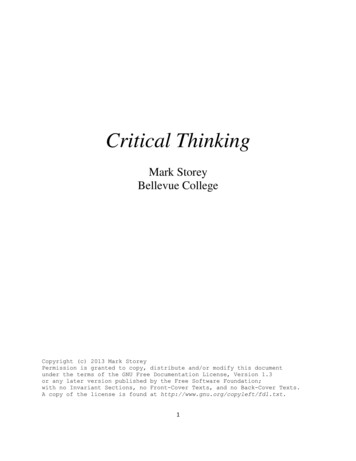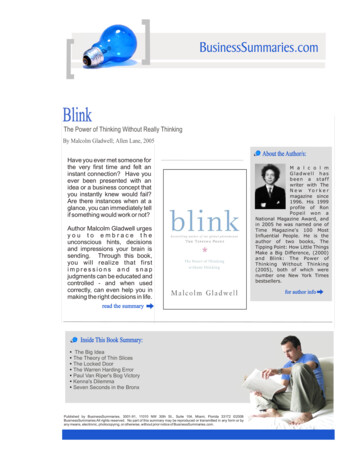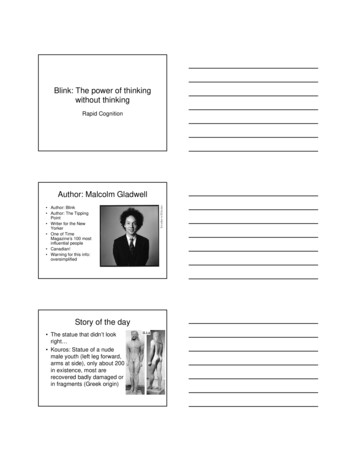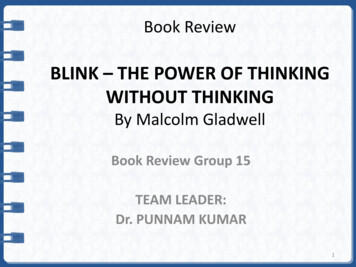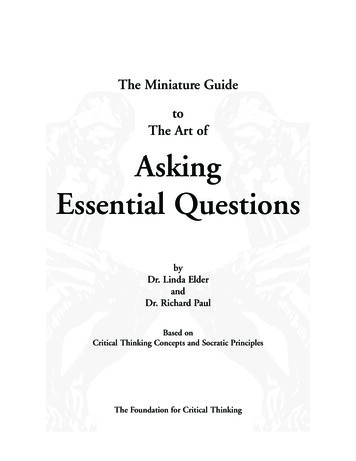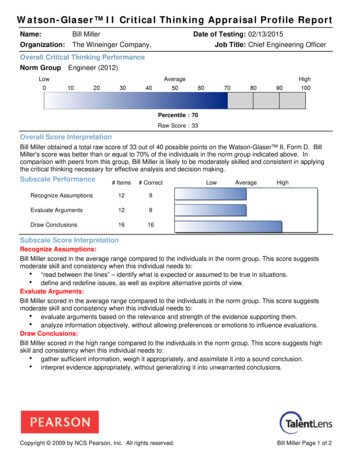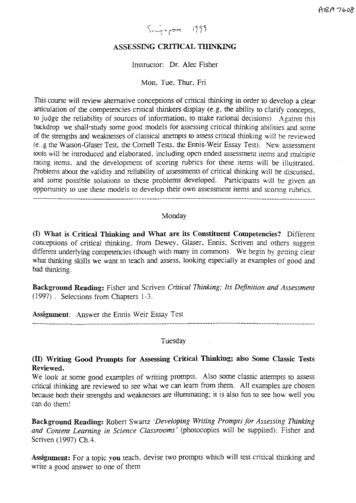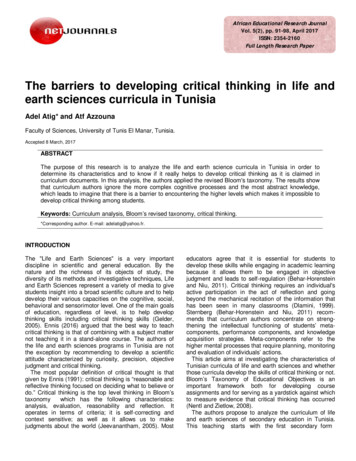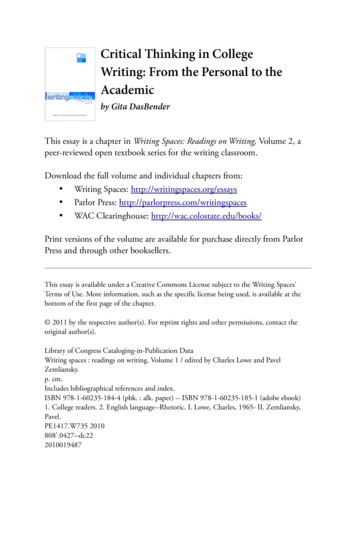
Transcription
Critical Thinking in CollegeWriting: From the Personal to theAcademicby Gita DasBenderThis essay is a chapter in Writing Spaces: Readings on Writing, Volume 2, apeer-reviewed open textbook series for the writing classroom.Download the full volume and individual chapters from: Writing Spaces: http://writingspaces.org/essays Parlor Press: http://parlorpress.com/writingspaces WAC Clearinghouse: http://wac.colostate.edu/books/Print versions of the volume are available for purchase directly from ParlorPress and through other booksellers.This essay is available under a Creative Commons License subject to the Writing Spaces'Terms of Use. More information, such as the specific license being used, is available at thebottom of the first page of the chapter. 2011 by the respective author(s). For reprint rights and other permissions, contact theoriginal author(s).Library of Congress Cataloging-in-Publication DataWriting spaces : readings on writing. Volume 1 / edited by Charles Lowe and PavelZemliansky.p. cm.Includes bibliographical references and index.ISBN 978-1-60235-184-4 (pbk. : alk. paper) -- ISBN 978-1-60235-185-1 (adobe ebook)1. College readers. 2. English language--Rhetoric. I. Lowe, Charles, 1965- II. Zemliansky,Pavel.PE1417.W735 2010808’.0427--dc222010019487
Critical Thinking in CollegeWriting: From the Personal to theAcademicGita DasBenderThere is something about the term “critical thinking” that makes youdraw a blank every time you think about what it means.* It seems sofuzzy and abstract that you end up feeling uncomfortable, as thoughthe term is thrust upon you, demanding an intellectual effort that youmay not yet have. But you know it requires you to enter a realm ofsmart, complex ideas that others have written about and that you haveto navigate, understand, and interact with just as intelligently. It’s a lotto ask for. It makes you feel like a stranger in a strange land.As a writing teacher I am accustomed to reading and respondingto difficult texts. In fact, I like grappling with texts that have interesting ideas no matter how complicated they are because I understandtheir value. I have learned through my years of education that whatultimately engages me, keeps me enthralled, is not just grammaticallypristine, fluent writing, but writing that forces me to think beyond thepage. It is writing where the writer has challenged herself and then offered up that challenge to the reader, like a baton in a relay race. Theidea is to run with the baton.* This work is licensed under the Creative Commons AttributionNoncommercial-ShareAlike 3.0 United States License and is subject to theWriting Spaces’ Terms of Use. To view a copy of this license, visit s/ or send a letter to CreativeCommons, 171 Second Street, Suite 300, San Francisco, California, 94105,USA. To view the Writing Spaces’ Terms of Use, visit http://writingspaces.org/terms-of-use.37
38Gita DasBenderYou will often come across critical thinking and analysis as requirements for assignments in writing and upper-level courses in a variety ofdisciplines. Instructors have varying explanations of what they actually require of you, but, in general, they expect you to respond thoughtfully to texts you have read. The first thing you should remember isnot to be afraid of critical thinking. It does not mean that you have tocriticize the text, disagree with its premise, or attack the writer simplybecause you feel you must. Criticism is the process of responding toand evaluating ideas, argument, and style so that readers understandhow and why you value these items.Critical thinking is also a process that is fundamental to all disciplines. While in this essay I refer mainly to critical thinking in composition, the general principles behind critical thinking are strikinglysimilar in other fields and disciplines. In history, for instance, it couldmean examining and analyzing primary sources in order to understand the context in which they were written. In the hard sciences, itusually involves careful reasoning, making judgments and decisions,and problem solving. While critical thinking may be subject-specific, that is to say, it can vary in method and technique depending onthe discipline, most of its general principles such as rational thinking,making independent evaluations and judgments, and a healthy skepticism of what is being read, are common to all disciplines. No matterthe area of study, the application of critical thinking skills leads toclear and flexible thinking and a better understanding of the subjectat hand.To be a critical thinker you not only have to have an informedopinion about the text but also a thoughtful response to it. There is nodoubt that critical thinking is serious thinking, so here are some stepsyou can take to become a serious thinker and writer.Attentive Reading: A Foundationfor Critical ThinkingA critical thinker is always a good reader because to engage criticallywith a text you have to read attentively and with an open mind, absorbing new ideas and forming your own as you go along. Let us imagine you are reading an essay by Annie Dillard, a famous essayist, called“Living like Weasels.” Students are drawn to it because the idea of theessay appeals to something personally fundamental to all of us: how to
Critical Thinking in College Writing39live our lives. It is also a provocative essay that pulls the reader into theargument and forces a reaction, a good criterion for critical thinking.So let’s say that in reading the essay you encounter a quote thatgives you pause. In describing her encounter with a weasel in HollinsPond, Dillard says, “I would like to learn, or remember, how to live . . .I don’t think I can learn from a wild animal how to live in particular. . . but I might learn something of mindlessness, something of thepurity of living in the physical senses and the dignity of living withoutbias or motive” (220). You may not be familiar with language like this.It seems complicated, and you have to stop ever so often (perhaps afterevery phrase) to see if you understood what Dillard means. You mayask yourself these questions: What does “mindlessness” mean in this context? How can one “learn something of mindlessness?” What does Dillard mean by “purity of living in the physicalsenses?” How can one live “without bias or motive?”These questions show that you are an attentive reader. Instead ofsimply glossing over this important passage, you have actually stoppedto think about what the writer means and what she expects you to getfrom it. Here is how I read the quote and try to answer the questionsabove: Dillard proposes a simple and uncomplicated way of life as shelooks to the animal world for inspiration. It is ironic that she admiresthe quality of “mindlessness” since it is our consciousness, our verycapacity to think and reason, which makes us human, which makes usbeings of a higher order. Yet, Dillard seems to imply that we need tolive instinctually, to be guided by our senses rather than our intellect.Such a “thoughtless” approach to daily living, according to Dillard,would mean that our actions would not be tainted by our biases ormotives, our prejudices. We would go back to a primal way of living,like the weasel she observes. It may take you some time to arrive atthis understanding on your own, but it is important to stop, reflect,and ask questions of the text whenever you feel stumped by it. Oftensuch questions will be helpful during class discussions and peer reviewsessions.
40Gita DasBenderListing Important IdeasWhen reading any essay, keep track of all the important points thewriter makes by jotting down a list of ideas or quotations in a notebook. This list not only allows you to remember ideas that are centralto the writer’s argument, ideas that struck you in some way or theother, but it also you helps you to get a good sense of the whole readingassignment point by point. In reading Annie Dillard’s essay, we comeacross several points that contribute toward her proposal for better living and that help us get a better understanding of her main argument.Here is a list of some of her ideas that struck me as important:1. “The weasel lives in necessity and we live in choice, hating necessity and dying at the last ignobly in its talons” (220).2. “And I suspect that for me the way is like the weasel’s: open totime and death painlessly, noticing everything, rememberingnothing, choosing the given with a fierce and pointed will”(221).3. “We can live any way we want. People take vows of poverty,chastity, and obedience—even of silence—by choice. Thething is to stalk your calling in a certain skilled and suppleway, to locate the most tender and live spot and plug into thatpulse” (221).4. “A weasel doesn’t ‘attack’ anything; a weasel lives as he’s meantto, yielding at every moment to the perfect freedom of singlenecessity” (221).5. “I think it would be well, and proper, and obedient, and pure,to grasp your one necessity and not let it go, to dangle from itlimp wherever it takes you” (221).These quotations give you a cumulative sense of what Dillard is tryingto get at in her essay, that is, they lay out the elements with which shebuilds her argument. She first explains how the weasel lives, what shelearns from observing the weasel, and then prescribes a lifestyle sheadmires—the central concern of her essay.
Critical Thinking in College Writing41Noticing Key Terms and SummarizingImportant QuotesWithin the list of quotations above are key terms and phrases that arecritical to your understanding of the ideal life as Dillard describes it.For instance, “mindlessness,” “instinct,” “perfect freedom of a singlenecessity,” “stalk your calling,” “choice,” and “fierce and pointed will”are weighty terms and phrases, heavy with meaning, that you need tospend time understanding. You also need to understand the relationship between them and the quotations in which they appear. This ishow you might work on each quotation to get a sense of its meaningand then come up with a statement that takes the key terms into account and expresses a general understanding of the text:Quote 1: Animals (like the weasel) live in “necessity,” whichmeans that their only goal in life is to survive. They don’tthink about how they should live or what choices they shouldmake like humans do. According to Dillard, we like to haveoptions and resist the idea of “necessity.” We fight death—aninevitable force that we have no control over—and yet ultimately surrender to it as it is the necessary end of our lives.Quote 2: Dillard thinks the weasel’s way of life is the best wayto live. It implies a pure and simple approach to life where wedo not worry about the passage of time or the approach ofdeath. Like the weasel, we should live life in the moment, intensely experiencing everything but not dwelling on the past.We should accept our condition, what we are “given,” with a“fierce and pointed will.” Perhaps this means that we shouldpursue our one goal, our one passion in life, with the samesingle-minded determination and tenacity that we see in theweasel.Quote 3: As humans, we can choose any lifestyle we want.The trick, however, is to go after our one goal, one passion likea stalker would after a prey.Quote 4: While we may think that the weasel (or any animal)chooses to attack other animals, it is really only surrenderingto the one thing it knows: its need to live. Dillard tells us thereis “the perfect freedom” in this desire to survive because to
42Gita DasBenderher, the lack of options (the animal has no other option thanto fight to survive) is the most liberating of all.Quote 5: Dillard urges us to latch on to our deepest passionin life (the “one necessity”) with the tenacity of a weasel andnot let go. Perhaps she’s telling us how important it is to havean unwavering focus or goal in life.Writing a Personal Response: Looking InwardDillard’s ideas will have certainly provoked a response in your mind,so if you have some clear thoughts about how you feel about the essaythis is the time to write them down. As you look at the quotes you haveselected and your explanation of their meaning, begin to create yourpersonal response to the essay. You may begin by using some of thesestrategies:1. Tell a story. Has Dillard’s essay reminded you of an experienceyou have had? Write a story in which you illustrate a point thatDillard makes or hint at an idea that is connected to her essay.2. Focus on an idea from Dillard’s essay that is personally important to you. Write down your thoughts about this idea in afirst person narrative and explain your perspective on the issue.3. If you are uncomfortable writing a personal narrative or using“I” (you should not be), reflect on some of her ideas that seemimportant and meaningful in general. Why were you struckby these ideas?4. Write a short letter to Dillard in which you speak to her aboutthe essay. You may compliment her on some of her ideas byexplaining why you like them, ask her a question related to heressay and explain why that question came to you, and genuinely start up a conversation with her.This stage in critical thinking is important for establishing your relationship with a text. What do I mean by this “relationship,” you mayask? Simply put, it has to do with how you feel about the text. Are youamazed by how true the ideas seem to be, how wise Dillard sounds?Or are you annoyed by Dillard’s let-me-tell-you-how-to-live approachand disturbed by the impractical ideas she so easily prescribes? Do youfind Dillard’s voice and style thrilling and engaging or merely confus-
Critical Thinking in College Writing43ing? No matter which of the personal response options you select, yourinitial reaction to the text will help shape your views about it.Making an Academic Connection: Looking OutwardFirst year writing courses are designed to teach a range of writing—from the personal to the academic—so that you can learn to expressadvanced ideas, arguments, concepts, or theories in any discipline.While the example I have been discussing pertains mainly to collegewriting, the method of analysis and approach to critical thinking Ihave demonstrated here will serve you well in a variety of disciplines.Since critical thinking and analysis are key elements of the reading andwriting you will do in college, it is important to understand how theyform a part of academic writing. No matter how intimidating the term“academic writing” may seem (it is, after all, associated with advancedwriting and becoming an expert in a field of study), embrace it not asa temporary college requirement but as a habit of mind.To some, academic writing often implies impersonal writing, writing that is detached, distant, and lacking in personal meaning or relevance. However, this is often not true of the academic writing youwill do in a composition class. Here your presence as a writer—yourthoughts, experiences, ideas, and therefore who you are—is of muchsignificance to the writing you produce. In fact, it would not be farfetched to say that in a writing class academic writing often beginswith personal writing. Let me explain. If critical thinking begins witha personal view of the text, academic writing helps you broaden thatview by going beyond the personal to a more universal point of view.In other words, academic writing often has its roots in one’s privateopinion or perspective about another writer’s ideas but ultimately goesbeyond this opinion to the expression of larger, more abstract ideas.Your personal vision—your core beliefs and general approach to life—will help you arrive at these “larger ideas” or universal propositionsthat any reader can understand and be enlightened by, if not agreewith. In short, academic writing is largely about taking a critical, analytical stance toward a subject in order to arrive at some compellingconclusions.Let us now think about how you might apply your critical thinking skills to move from a personal reaction to a more formal academic
44Gita DasBenderresponse to Annie Dillard’s essay. The second stage of critical thinkinginvolves textual analysis and requires you to do the following: Summarize the writer’s ideas the best you can in a brief paragraph. This provides the basis for extended analysis since itcontains the central ideas of the piece, the building blocks,so to speak. Evaluate the most important ideas of the essay by consideringtheir merits or flaws, their worthiness or lack of worthiness.Do not merely agree or disagree with the ideas but explore andexplain why you believe they are socially, politically, philosophically, or historically important and relevant, or why youneed to question, challenge, or reject them. Identify gaps or discrepancies in the writer’s argument. Doesshe contradict herself? If so, explain how this contradictionforces you to think more deeply about her ideas. Or if you areconfused, explain what is confusing and why. Examine the strategies the writer uses to express her ideas.Look particularly at her style, voice, use of figurative language, and the way she structures her essay and organizes herideas. Do these strategies strengthen or weaken her argument?How? Include a second text—an essay, a poem, lyrics of a song—whose ideas enhance your reading and analysis of the primarytext. This text may help provide evidence by supporting apoint you’re making, and further your argument. Extend the writer’s ideas, develop your own perspective, andpropose new ways of thinking about the subject at hand.Crafting the EssayOnce you have taken notes and developed a thorough understandingof the text, you are on your way to writing a good essay. If you wereasked to write an exploratory essay, a personal response to Dillard’s essay would probably suffice. However, an academic writing assignmentrequires you to be more critical. As counter-intuitive as it may sound,beginning your essay with a personal anecdote often helps to establishyour relationship to the text and draw the reader into your writing. Italso helps to ease you into the more complex task of textual analysis.Once you begin to analyze Dillard’s ideas, go back to the list of im-
Critical Thinking in College Writing45portant ideas and quotations you created as you read the essay. Aftera brief summary, engage with the quotations that are most important,that get to the heart of Dillard’s ideas, and explore their meaning.Textual engagement, a seemingly slippery concept, simply means thatyou respond directly to some of Dillard’s ideas, examine the value ofDillard’s assertions, and explain why they are worthwhile or why theyshould be rejected. This should help you to transition into analysisand evaluation. Also, this part of your essay will most clearly reflectyour critical thinking abilities as you are expected not only to representDillard’s ideas but also to weigh their significance. Your observationsabout the various points she makes, analysis of conflicting viewpointsor contradictions, and your understanding of her general thesis shouldnow be synthesized into a rich new idea about how we should live ourlives. Conclude by explaining this fresh point of view in clear, compelling language and by rearticulating your main argument.Modeling Good WritingWhen I teach a writing class, I often show students samples of reallygood writing that I’ve collected over the years. I do this for two reasons: first, to show students how another freshman writer understoodand responded to an assignment that they are currently working on;and second, to encourage them to succeed as well. I explain that although they may be intimidated by strong, sophisticated writing andfeel pressured to perform similarly, it is always helpful to see what ittakes to get an A. It also helps to follow a writer’s imagination, to learnhow the mind works when confronted with a task involving criticalthinking. The following sample is a response to the Annie Dillard essay. Figure 1 includes the entire student essay and my comments areinserted into the text to guide your reading.Though this student has not included a personal narrative in hisessay, his own world-vievvw is clear throughout. His personal point ofview, while not expressed in first person statements, is evident from thevery beginning. So we could say that a personal response to the textneed not always be expressed in experiential or narrative form but maybe present as reflection, as it is here. The point is that the writer hastraveled through the rough terrain of critical thinking by starting outwith his own ruminations on the subject, then by critically analyzingand responding to Dillard’s text, and finally by developing a strong
46Gita yinfreshwords.
Critical Thinking in College utalsotheabilitytorecognizewhy mostpeoplecannotlivethisway.This isagoodexample of critical plainingwhyitisimportanttorejectthem.
48Gita .Whereastheconscious- lifecouldbeachievedifonlyweweresimple- ownwriting.
Critical Thinking in College Writinginterestinglife,onemayevensayacare- cio- inkalongwiththewriter.
50Gita apon,
Critical Thinking in College Writing: From the Personal to the Academic by Gita DasBender This essay is a chapter in Writing Spaces: Readings on Writing, Volume 2, a peer
